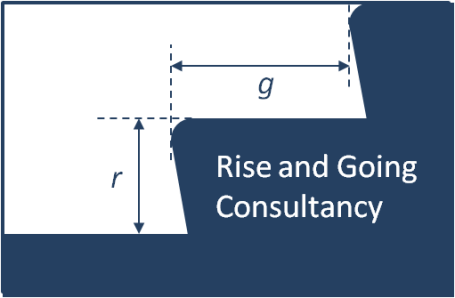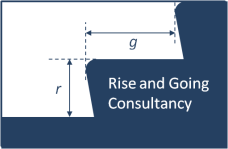
This Risk pyramid highlights the level of risk associated with falls on Stairs
Each Year in the UK approximately:
- 700+ people die from a fall on stairs
- 2 falls a day on average
- Over 26,000 people are hospitalized
- 3 falls every hour
- More than 380 thousand visit A&E
- a further 43 falls every hour
- And there are likely to be over 3 Million minor falls on stairs each year with less serious injuries
There are four main stair design elements known to have an impact on the risk of falls on stairs:
Size of Steps
The larger the steps the safer the stairs
Variation in steps
Consistent steps are safer
Handrails
Using graspable handrails reduces risk
Lighting
Lighting on stairs can illuminate hazards
Smaller steps greatly increase the risk of a fall
- An estimated 11-12% of dwelling stairs built to current building regulations will experience a fall every 2 years
- The risk of a fall increases with smaller steps
- 30% increase in risk from 201-220 mm going
- 75% increase for even shorter steps
- Larger steps decrease the risk
- 241-250 mm with a 30% reduction in risk
- A 60% reduction for steps with goings > 250 mm


Risk increases with smaller going sizes and variation between steps where one going on the flight is shorter than the rest
This chart shows the relative risk of an overstep (which might lead to a fall) in descent for a family on a typical domestic stair of 13 steps compared to the risk on a stair with 300 mm going and 0 mm variation between steps

300mm going/0mm variance
Recommended minimum going for all stairs
- Relative risk 1
- 1 in 8,000 years

300mm going/15mm variance
Variance in one step increases the risk of an overstep
- Relative risk 273 times
- 1 in 29 years

275mm going/5mm variance
A smaller going has a 2 to 3 orders of magnitude increase in risk
- Relative risk 1,076 times
- 1 in 7 years

250mm going/0mm variance
2 orders of magnitude rise in risk even with no variance
- Relative risk 2,708 times
- 1 in 3 years

225mm going/1mm variance
A typical domestic stair built to current building regulations
- Relative risk 10,000 times
- 1 in 292 days

Handrails don't reduce the risk of a fall
Handrails, if graspable and at the right height make a stair more accessible and usable, and can reduce the severity of a fall should one occur

Graspable handrail
A power grip can be achieved, that is your thumb can reach your fingers when holding the rail. (Perimeter of 100mm-160mm)

Non-graspable handrail
A power grip cannot be achieved on this rail, instead only a pinch grip is used. The handrail is still useful for guidance and support
Lighting on stairs highlights possible hazards
If you are familiar with a stair, you can use them in the dark, especially if you hold the handrails
But in the light, it is possible to assess the stairs before use to see if there are any hazards on the steps which might hinder your progress


We need your consent to load the translations
We use a third-party service to translate the website content that may collect data about your activity. Please review the details and accept the service to view the translations.

